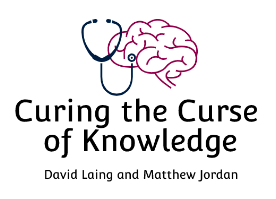Lesson 3: Bottom-Up Explanations
Hello and welcome to lesson three of Curing the Curse of Knowledge! In the previous lesson, we argued that reader-centric writing is an act of empathy that most people rarely practice. This time, we discuss a form of writing that requires immense empathy for readers: explanation.
There are two main ways to explain a difficult concept: from the top down and from the bottom up. To show you what that means, here are two explanations of the difference between probability and statistics. As you read them, ask yourself: which is more readable? Here is the top-down version:
Probability and statistics are both branches of mathematics that involve randomness, but they have distinct purposes. Probability is about making predictions under uncertainty, while statistics is about making inferences about the patterns underlying observations. For example, suppose you have a bag of 1000 balls that are either blue or red. If you know the proportion of balls that are red, you can use it to compute the probability that a randomly selected ball will be red. But if you don’t know the proportion, you will have to estimate it by taking samples and using statistics.
By contrast, here is the bottom-up version:
Suppose you have a bag that contains 1000 balls, and each ball is either blue or red. If you know the proportion of balls that are red, then you can compute the probability that a randomly selected ball will turn out to be red. But if you don’t know the proportion of red balls, you will have to estimate it by taking samples and using statistics. Probability is therefore about making predictions, while statistics is about making inferences about the patterns underlying observations. So, while probability and statistics both involve randomness, they have distinct purposes.
Hopefully you found the difference between the two explanations easy to spot: the top-down version started with abstractions and then dove into examples, while the bottom-up version used examples as scaffolding to prop up the abstractions.
The most pernicious effect of the Curse of Knowledge on writers is that it causes them to default to top-down explanations. When you know a subject well, you think of it in abstractions. Lawyers think of the law in terms of justice, precedence, and constitutionality. Programmers think of software in terms of functions, classes, and APIs. Thinking in abstractions is no sin, of course; it’s what makes experts experts. The problem is that abstractions are the last thing newcomers need to see.
When you are new to a subject, the first thing you need to see is examples. In our case, it’s much easier to imagine a bag of blue and red balls than to imagine branches of mathematics. When writers provide examples at the beginning of their explanations, they give their readers something concrete to hold onto as they move through the abstract details.
Notice that this lesson is itself a bottom-up explanation! We used the two explanations of probability and statistics to introduce top-down and bottom-up explanations, and we are now making our way through the implications.
We are not saying that top-down explanations are never appropriate. They are appropriate for audiences who have encountered a concept before and need to be merely reminded of it. Think of how reference manuals don’t contain full lessons for each of their entries; they are not even explanations so much as they are quick refreshers. This is a case where the top-down approach is ideal.
Occasionally, top-down explanations are also preferable for extremely simple concepts. Imagine reading an explanation of the term ‘clockwise’ that went something like, “Imagine in your mind the hands on a clock moving in a circle. This direction of rotation is called clockwise”. You would assume the piece was written for children.
However, because of the Curse of Knowledge, what seems simple to you will often seem complex to your readers. This is why you should always default to bottom-up explanations. Assume your reader will be grateful that you began with concrete examples, because for most things worth writing about, this assumption is correct. Only switch to top-down when you are certain that your reader has encountered the concept before, or when starting with examples feels so condescending that it makes you squirm.
For this lesson’s activity, we’d like you to rearrange the following explanation from top-down to bottom-up. You should be able to get most of the way there by cutting sentences from one location and pasting them into another, though you will need to do a bit of stitching together too. Here is the top-down explanation:
A garden path sentence is one that leads the reader “down the garden path” to an interpretive dead end, forcing them to stop and reread. This effect is usually caused by pairs of words whose statistical associations suggest unintended grammatical functions. For example, consider the sentence, “The old man the boat.” Believe it or not, the sentence is grammatically sound. The problem is that the words ‘old’ and ‘man’, which are often used together, are not serving their usual purposes. Here, ‘old’ is not an adjective but a noun (meaning ‘the old people’), and ‘man’ is not a noun but a verb (meaning ‘to operate’). Therefore, the sentence means “the old people operate the boat.”
Send us your bottom-up version to, and we’ll send you ours!
In our next lesson, we’ll show you how to produce clearer writing at the sentence level.
